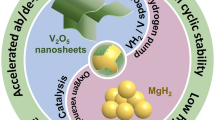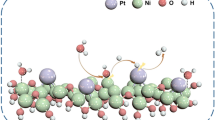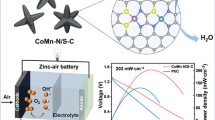Abstract
The oxygen evolution reaction (OER) represents the rate-determining step of electrocatalytic water splitting into hydrogen and oxygen. Creating oxygen vacancies and adjusting their density has proven to be an effective strategy to design high-performance OER catalysts. Herein, a hydrogenation method is applied to treat a two-dimensional (2D) iron-cobalt oxide (Fe1Co1Ox-origin), with the purpose of tuning its oxygen vacancy density. Notably, compared with Fe1Co1Ox-origin, the iron-cobalt oxide hydrogenated at 200 °C and 2.0 MPa optimized conditions exhibits a markedly improved OER activity in 1.0 M KOH (with an overpotential η of 225 mV at a current density of 10 mA·cm–2) and a rapid reaction kinetics (with a Tafel slope of 36.0 mV·dec–1). Moreover, the OER mass activity of the hydrogenated oxide is 1.9 times that of Fe1Co1Ox-origin at an overpotential of 350 mV. The experimental results, combined with density functional theory (DFT) calculations, reveal that the optimal control of oxygen vacancies in 2D Fe1Co1Ox via hydrogenation can improve the electronic conductivity and promote OH– adsorption onto nearby low-coordinated Co3+ sites, resulting in a significantly enhanced OER activity.

Similar content being viewed by others
References
Novoselov, K. S.; Geim, A. K.; Morozov, S. V.; Jiang, D.; Zhang, Y.; Dubonos, S. V.; Grigorieva, I. V.; Firsov, A. A. Electric field effect in atomically thin carbon films. Science 2004, 306, 666–669.
Meyer, J. C.; Geim, A. K.; Katsnelson, M. I.; Novoselov, K. S.; Booth, T. J.; Roth, S. The structure of suspended graphene sheets. Nature 2007, 446, 60–63.
Kibsgaard, J.; Chen, Z. B.; Reinecke, B. N.; Jaramillo, T. F. Engineering the surface structure of MoS2 to preferentially expose active edge sites for electrocatalysis. Nat. Mater. 2012, 11, 963–969.
Li, G. Q.; Zhang, D.; Qiao, Q.; Yu, Y. F.; Peterson, D.; Zafar, A.; Kumar, R.; Curtarolo, S.; Hunte, F.; Shannon, S. et al. All the catalytic active sites of MoS2 for hydrogen evolution. J. Am. Chem. Soc. 2016, 138, 16632–16638.
Voiry, D.; Yamaguchi, H.; Li, J. W.; Silva, R.; Alves, D. C. B.; Fujita, T.; Chen, M. W.; Asefa, T.; Shenoy, V. B.; Eda, G. et al. Enhanced catalytic activity in strained chemically exfoliated WS2 nanosheets for hydrogen evolution. Nat. Mater. 2013, 12, 850–855.
Gao, M. R.; Cao, X.; Gao, Q.; Xu, Y. F.; Zheng, Y. R.; Jiang, J.; Yu, S. H. Nitrogen-doped graphene supported CoSe2 nanobelt composite catalyst for efficient water oxidation. ACS Nano 2014, 8, 3970–3978.
Stern, L.-A.; Feng, L. G.; Song, F.; Hu, X. L. Ni2P as a Janus catalyst for water splitting: The oxygen evolution activity of Ni2P nanoparticles. Energy Environ. Sci. 2015, 8, 2347–2351.
Jia, X. D.; Zhao, Y. F.; Chen, G. B.; Shang, L.; Shi, R.; Kang, X. F.; Waterhouse, G. I. N.; Wu, L. Z.; Tung C.-H.; Zhang, T. R. Ni3FeN nanoparticles derived from ultrathin NiFe-layered double hydroxide nanosheets: An efficient overall water splitting electrocatalyst. Adv. Energy Mater. 2016, 6, 1502585.
Zhuang, L. Z.; Ge, L.; Yang, Y. S.; Li, M. R.; Jia, Y.; Yao, X. D.; Zhu, Z. H. Ultrathin iron-cobalt oxide nanosheets with abundant oxygen vacancies for the oxygen evolution reaction. Adv. Mater. 2017, 29, 1606793.
Lei, F. C.; Sun, Y. F.; Liu, K. T.; Gao, S.; Liang, L.; Pan, B. C.; Xie, Y. Oxygen vacancies confined in ultrathin indium oxide porous sheets for promoted visible-light water splitting. J. Am. Chem. Soc. 2014, 136, 6826–6829.
Liu, X. J.; Chang, Z.; Luo, L.; Xu, T. H.; Lei, X. D.; Liu, J. F.; Sun, X. M. Hierarchical ZnxCo3–xO4 nanoarrays with high activity for electrocatalytic oxygen evolution. Chem. Mater. 2014, 26, 1889–1895.
Song, F.; Hu, X. L. Exfoliation of layered double hydroxides for enhanced oxygen evolution catalysis. Nat. Commun. 2014, 5, 4477.
Friebel, D.; Louie, M. W.; Bajdich, M.; Sanwald, K. E.; Cai, Y.; Wise, A. M.; Cheng, M. J.; Sokaras, D.; Weng, T. C.; Alonso-Mori, R. et al. Identification of highly active Fe sites in (Ni, Fe)OOH for electrocatalytic water splitting. J. Am. Chem. Soc. 2015, 137, 1305–1313.
Zhang, B.; Zheng, X. L.; Voznyy, O.; Comin, R.; Bajdich, M.; García-Melchor, M.; Han, L. L.; Xu, J. X.; Liu, M.; Zheng, L. R. et al. Homogeneously dispersed multimetal oxygenevolving catalysts. Science 2016, 352, 333–337.
Gong, M.; Li, Y. G.; Wang, H. L.; Liang, Y. Y.; Wu, J. Z.; Zhou, J. G.; Wang, J.; Regier, T.; Wei, F.; Dai, H. J. An advanced Ni-Fe layered double hydroxide electrocatalyst for water oxidation. J. Am. Chem. Soc. 2013, 135, 8452–8455.
Jia, Y. Zhang, L. Z.; Gao, G. P.; Chen, H.; Wang, B.; Zhou, J. Z.; Soo, M. T.; Hong, M.; Yan, X. C.; Qian, G. R. et al. A heterostructure coupling of exfoliated Ni-Fe hydroxide nanosheet and defective graphene as a bifunctional electrocatalyst for overall water splitting. Adv. Mater. 2017, 29, 1700017.
Guo, Y. Q.; Xu, K.; Wu, C. Z.; Zhao, J. Y.; Xie, Y. Surface chemical-modification for engineering the intrinsic physical properties of inorganic two-dimensional nanomaterials. Chem. Soc. Rev. 2015, 44, 637–646.
Huang, Z. F.; Wang, J.; Peng, Y. C.; Jung, C. Y.; Fisher, A.; Wang, X. Design of efficient bifunctional oxygen reduction/ evolution electrocatalyst: Recent advances and perspectives. Adv. Energy Mater. 2017, 7, 1700544.
Li, Y. B.; Zhang, H. M.; Wang, Y.; Liu, P. R.; Yang, H. G.; Yao, X. D.; Wang, D.; Tang, Z. Y.; Zhao, H. J. A selfsponsored doping approach for controllable synthesis of S and N co-doped trimodal-porous structured graphitic carbon electrocatalysts. Energy Environ. Sci. 2014, 7, 3720–3726.
Zheng, Y.; Jiao, Y.; Li, L. H.; Xing, T.; Chen, Y.; Jaroniec, M.; Qiao, S. Z. Toward design of synergistically active carbonbased catalysts for electrocatalytic hydrogen evolution. ACS Nano 2014, 8, 5290–5296.
Liu, G. L.; Robertson, A. W.; Li, M. M.-J.; Kuo, W. C. H.; Darby, M. T.; Muhieddine, M. H.; Lin, Y.-C.; Suenaga, K.; Stamatakis, M.; Warner, J. H. et al. MoS2 monolayer catalyst doped with isolated Co atoms for the hydrodeoxygenation reaction. Nat. Chem. 2017, 9, 810–816.
Qiao, B. T.; Wang, A. Q.; Yang, X. F.; Allard, L. F.; Jiang, Z.; Cui, Y. T.; Liu, J. Y.; Li, J.; Zhang, T. Single-atom catalysis of CO oxidation using Pt1/FeOx. Nat. Chem. 2011, 3, 634–641.
Jia, Y.; Zhang, L. Z.; Du, A. J.; Gao, G. P.; Chen, J.; Yan, X. C.; Brown, C. L.; Yao, X. D. Defect graphene as a trifunctional catalyst for electrochemical reactions. Adv. Mater. 2016, 28, 9532–9538.
Ye, G. L.; Gong, Y. J.; Lin, J. H.; Li, B.; He, Y. M.; Pantelides, S. T.; Zhou, W.; Vajtai, R.; Ajayan, P. M. Defects engineered monolayer MoS2 for improved hydrogen evolution reaction. Nano Lett. 2016, 16, 1097–1103.
Chen, X. B.; Liu, L.; Yu, P. Y.; Mao, S. S. Increasing solar absorption for photocatalysis with black hydrogenated titanium dioxide nanocrystals. Science 2011, 331, 746–750.
Li, H.; Tsai, C.; Koh, A. L.; Cai, L. L.; Contryman, A. W.; Fragapane, A. H.; Zhao, J. H.; Han, H. S.; Manoharan, H. C.; Abild-Pedersen, F. et al. Activating and optimizing MoS2 basal planes for hydrogen evolution through the formation of strained sulphur vacancies. Nat. Mater. 2016, 15, 48–53.
Li, G. W.; Blake, G. R.; Palstra, T. T. M. Vacancies in functional materials for clean energy storage and harvesting: The perfect imperfection. Chem. Soc. Rev. 2017, 46, 1693–1706.
Wang, G. M.; Wang, H. Y.; Ling, Y. C.; Tang, Y. C.; Yang, X. Y.; Fitzmorris, R. C.; Wang, C. C.; Zhang, J. Z.; Li, Y. Hydrogen-treated TiO2 nanowire arrays for photoelectrochemical water splitting. Nano Lett. 2011, 11, 3026–3033.
Xu, L.; Jiang, Q. Q.; Xiao, Z. H.; Li, X. Y.; Huo, J.; Wang, S. Y.; Dai, L. M. Plasma-engraved Co3O4 nanosheets with oxygen vacancies and high surface area for the oxygen evolution reaction. Angew. Chem., Int. Ed. 2016, 55, 5277–5281.
Bao, J.; Zhang, X. D.; Fan, B.; Zhang, J. J.; Zhou, M.; Yang, W. L.; Hu, X.; Wang, H.; Pan, B. C.; Xie, Y. Ultrathin spinel-structured nanosheets rich in oxygen deficiencies for enhanced electrocatalytic water oxidation. Angew. Chem., Int. Ed. 2015, 54, 7399–7404.
Xiao, Z. H.; Wang, Y.; Huang, Y.-C.; Wei, Z. X.; Dong, C.-L.; Ma, J. M.; Shen, S. H.; Li, Y. F.; Wang, S. Y. Filling the oxygen vacancies in Co3O4 with phosphorus: An ultraefficient electrocatalyst for overall water splitting. Energy Environ. Sci. 2017, 10, 2563–2569.
Hadt, R. G.; Hayes, D.; Brodsky, C. N.; Ullman, A. M.; Casa, D. M.; Upton, M. H.; Nocera, D. G.; Chen, L. X. X-ray spectroscopic characterization of Co(IV) and metal-metal interactions in Co4O4: Electronic structure contributions to the formation of high-valent states relevant to the oxygen evolution reaction. J. Am. Chem. Soc. 2016, 138, 11017–11030.
Wang, Y. C.; Zhou, T.; Jiang, K.; Da, P. M.; Peng, Z.; Tang, J.; Kong, B.; Cai, W. B.; Yang, Z. Q.; Zheng, G. F. Reduced mesoporous Co3O4 nanowires as efficient water oxidation electrocatalysts and supercapacitor electrodes. Adv. Energy Mater. 2014, 4, 1400696.
Wang, J.; Ge, X. M.; Liu, Z. L.; Thia, L.; Yan, Y.; Xiao, W.; Wang, X. Heterogeneous electrocatalyst with molecular cobalt ions serving as the center of active sites. J. Am. Chem. Soc. 2017, 139, 1878–1884.
Chen, J. M.; Chin, Y. Y.; Valldor, M.; Hu, Z. W.; Lee, J. M.; Haw, S. C.; Hiraoka, N.; Ishii, H.; Pao, C. W.; Tsuei, K. D. et al. A complete high-to-low spin state transition of trivalent cobalt ion in octahedral symmetry in SrCo0.5Ru0.5O3–δ. J. Am. Chem. Soc. 2014, 136, 1514–1519.
Mashino, I.; Ohtani, E.; Hirao, N.; Mitsui, T.; Masuda, R.; Seto, M.; Sakai, T.; Takahashi, S.; Nakano, S. The spin state of iron in Fe3+-bearing Mg-perovskite and its crystal chemistry at high pressure. Am. Mineral. 2014, 99, 1555–1561.
Fei, H. L.; Dong, J. C.; Arellano-Jiménez, M. J.; Ye, G. L.; Kim, N. D.; Samuel, E. L. G.; Peng, Z. W.; Zhu, Z. A.; Qin, F.; Bao, J. M. et al. Atomic cobalt on nitrogen-doped graphene for hydrogen generation. Nat. Commun. 2015, 6, 8668.
Kibsgaard, J.; Jaramillo, T. F. Molybdenum phosphosulfide: An active, acid-stable, earth-abundant catalyst for the hydrogen evolution reaction. Angew. Chem., Int. Ed. 2014, 53, 14433–14437.
Acknowledgements
The financial support from ARC is highly appreciated, through ARC Discovery Project (No. DP170103317), ARC Future Fellowship (No. FT120100720) and ARC Discovery Early Career Researcher Award (No. ARC DE180101030). L. Z. Z. acknowledges the support from International Postgraduate Research Scholarship (IPRS) and UQ Centennial Scholarship (UQCent). The authors acknowledge the scientific and technical assistance of the Australian Microscopy and Microanalysis Research Facility at the UQ Centre.
Author information
Authors and Affiliations
Corresponding authors
Electronic supplementary material
12274_2018_2050_MOESM1_ESM.pdf
Tuning oxygen vacancies in two-dimensional iron-cobalt oxide nanosheets through hydrogenation for enhanced oxygen evolution activity
Rights and permissions
About this article
Cite this article
Zhuang, L., Jia, Y., He, T. et al. Tuning oxygen vacancies in two-dimensional iron-cobalt oxide nanosheets through hydrogenation for enhanced oxygen evolution activity. Nano Res. 11, 3509–3518 (2018). https://doi.org/10.1007/s12274-018-2050-8
Received:
Revised:
Accepted:
Published:
Issue Date:
DOI: https://doi.org/10.1007/s12274-018-2050-8




